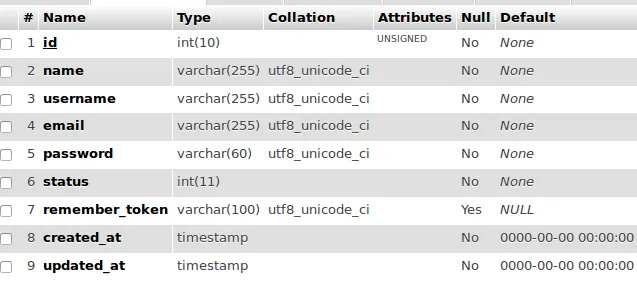我已经在Laravel 5中创建了以下登录表单,我希望能够简单地检查用户名和密码是否与数据库表格中的匹配,如果匹配,则重定向到仪表板页面,否则停留在登录页面。我也在试图自己找到解决方案,但我想请教如何在Laravel 5中完成这些操作。
有任何想法吗?
2015_09_10_050324_admin_details.php(迁移)
有任何想法吗?
2015_09_10_050324_admin_details.php(迁移)
<?php
use Illuminate\Database\Schema\Blueprint;
use Illuminate\Database\Migrations\Migration;
class AdminDetails extends Migration
{
/**
* Run the migrations.
*
* @return void
*/
public function up()
{
Schema::create('admin_details', function (Blueprint $table) {
$table->increments('id');
$table->string('name');
$table->string('username')->unique();
$table->string('email')->unique();
$table->string('password', 60);
$table->integer('status');
$table->rememberToken();
$table->timestamps();
});
}
/**
* Reverse the migrations.
*
* @return void
*/
public function down()
{
Schema::drop('admin_details');
}
}
数据库结构
login.blade.php(视图)
<form name="frmLogin" action="{{ URL::to('administrator/userAuthentication') }}" method="post">
<input name="_token" type="hidden" value="{{ csrf_token() }}"/>
<div class="form-group has-feedback">
<input type="text" name="username" id="username"class="form-control" placeholder="Username">
<span class="glyphicon glyphicon-envelope form-control-feedback"></span>
</div>
<div class="form-group has-feedback">
<input type="password" name="password" id="password" class="form-control" placeholder="Password">
<span class="glyphicon glyphicon-lock form-control-feedback"></span>
</div>
<div class="row">
<div class="col-xs-4">
<button type="submit" class="btn btn-primary btn-block btn-flat">Login</button>
</div><!-- /.col -->
</div>
</form>
AdminLoginController.php(控制器)
<?php
namespace App\Http\Controllers;
use Illuminate\Http\Request;
use App\Http\Requests;
use Auth;
use App\Http\Controllers\Controller;
use App\AdminLoginModel;
class AdminLoginController extends Controller
{
/**
* Display a listing of the resource.
*
* @return Response
*/
public function index()
{
return view('backend.login');
}
/**
* Handle an authentication attempt for admin user.
*
*/
public function userAuthentication(Request $request)
{
if (Auth::attempt(array('username' => $request->username, 'password' => $request->password))){
return "success";
}else{
return "Wrong Credentials";
}
die;
}
}
AdminLoginModel.php (model)
<?php
/*namespace App;
use DB;
use Illuminate\Database\Eloquent\Model;*/
namespace App;
use Illuminate\Auth\Authenticatable;
use Illuminate\Database\Eloquent\Model;
use Illuminate\Auth\Passwords\CanResetPassword;
use Illuminate\Contracts\Auth\Authenticatable as AuthenticatableContract;
use Illuminate\Contracts\Auth\CanResetPassword as CanResetPasswordContract;
class AdminLoginModel extends Model implements AuthenticatableContract, CanResetPasswordContract
{
use Authenticatable, CanResetPassword;
protected $table = 'admin_details';
protected $fillable = ['username', 'password'];
}
routes.php
<?php
/*
|--------------------------------------------------------------------------
| Application Routes
|--------------------------------------------------------------------------
|
| Here is where you can register all of the routes for an application.
| It's a breeze. Simply tell Laravel the URIs it should respond to
| and give it the controller to call when that URI is requested.
|
*/
Route::get('/', function () {
return view('welcome');
});
Route::resource('dashboard','DashboardController');
Route::resource('administrator','AdminLoginController');
Route::resource('users','AdminLoginController');
Route::resource('administrator/userAuthentication', 'AdminLoginController@userAuthentication');

